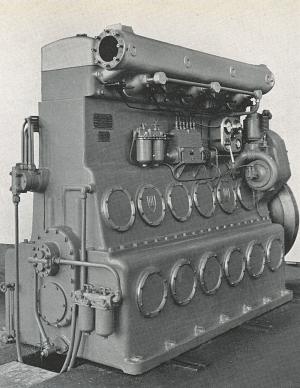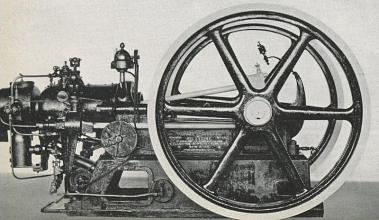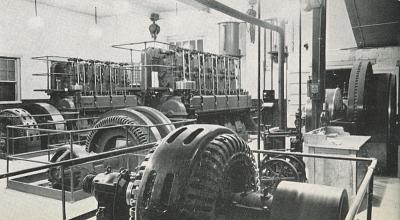
Model VE high speed
De La Vergne Diesel Engine
Vergne Engine Company on May 11, 1931, the
De La Vergne Machine Company having been
dissolved in 1929.
Although Prohibition had made a serious differ-
ence in the business for breweries, at the beginning
of the depression De La Vergne was supplying re-
frigeration equipment to a market of over two
hundred industries using mechanical cooling. This
was, of course, in addition to the manufacture of
Diesel Engines of Marine and stationary type.
Air conditioning has been De La Vergne's latest
pioneering achievement. The application of this
science has developed since 1931 logically and
naturally out of the mechanical refrigeration in-
dustry.
John Scott, a chemist of Edinburgh, in 1816 be-
queathed a sum of money to the City of Phila-
delphia, the income from which is each year awarded
Hornsby-Akroyd Engine built by De La Vergne
first commercialy successful oil engine in world.
|
to the inventors of the most meritorious devices for
the improvement of the health and comfort of the
human race. These awards have been made each
year since 1869 and in 1933 the John Scott Medal
for "inventions which add to the comfort of the
human race" was awarded by the City of Phila-
delphia to four De La Vergne engineers. These four
were the inventors and designers of that unique
feature, reverse cycle refrigeration, of the De La
Vergne air conditioner, by means of which the same
unit heats as well as cools.
DIESEL ENGINE BUSINESS GROWS
Meanwhile the Diesel engine business had de-
veloped very rapidly. During the years immediately
following the purchase of the rights to manufacture
the Hornsby-Akroyd engine, De La Vergne adapted
the Hornsby engine to the requirements of the
American market and designed engines of larger
sizes than had ever before been produced.
In 1904 experiments were started with a vertical
two-cycle hot bulb engine with crankcase compres-
sion and solid injection of the fuel oil, which al-
though having the drawbacks of its type, had such
an efficient combustion that it was decided to
build a four cycle engine on similar lines.
When it was found that the development of
spray nozzles and high pressure fuel pumps for
larger size engines would be a long drawn out pro-
cess, De La Vergne designed a four cycle engine
with air injection in which they could make use of
the experience gained by the early Diesel engine
builders.
The first De La Vergne Diesel engine with air
injection was built in 1915. While this type was
being developed and larger sizes of the former type
were being built, experiments with the airless or
solid injection type of engine were continued. In
1913 De La Vergne brought out a solid injection
type engine with hot surface ignition, and in 1917
was ready to place on the market the first Diesel
engine without an air compressor. The last air
(Continued on Page 28)
Modern installation De La Vergne Engines
in Municipal Plant at La Crosse, Kansas.
|

